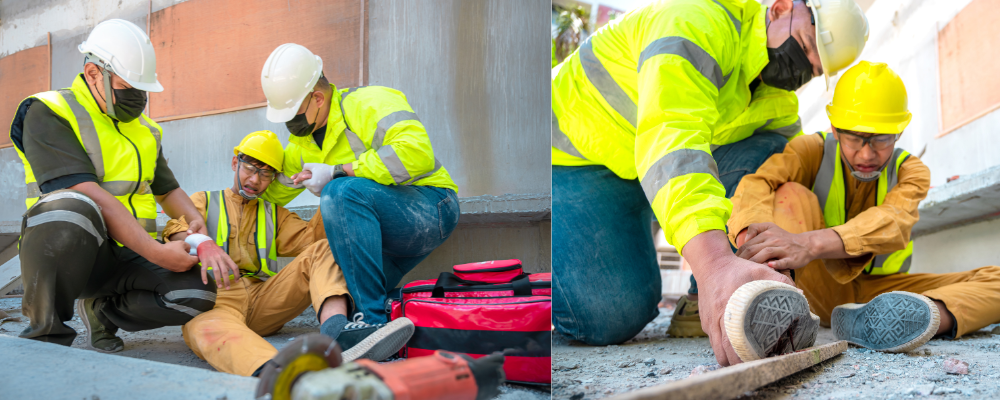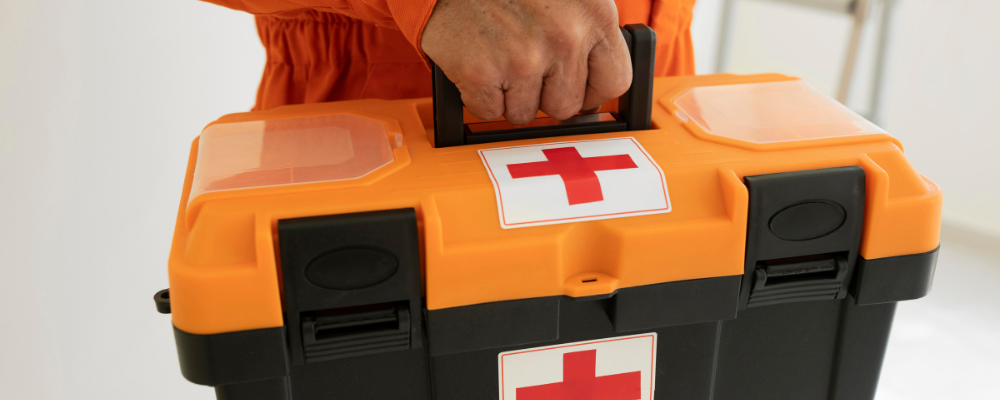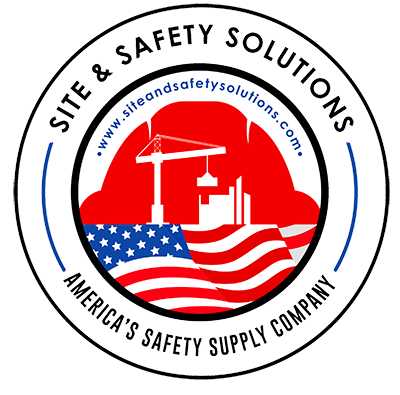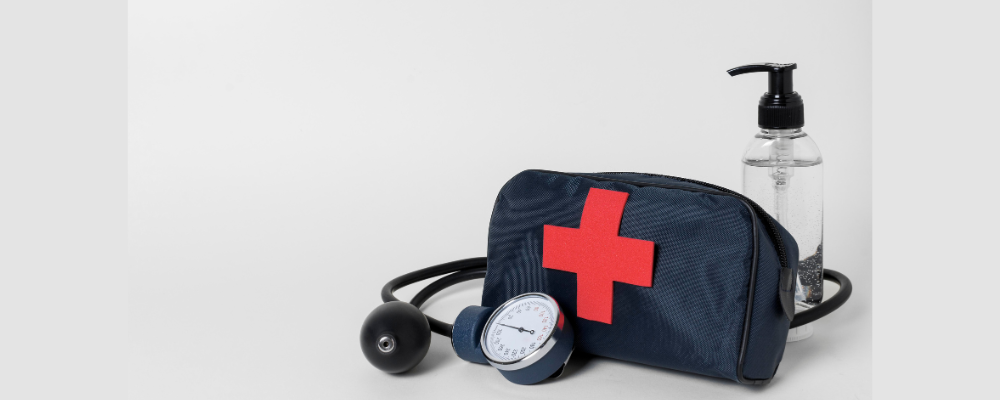
Introduction:
In the construction industry, prioritizing safety is paramount. Understanding and implementing proper First Aid measures can significantly mitigate risks and ensure the well-being of workers on-site. Site and Safety Solutions is committed to equipping construction teams with the necessary tools and knowledge to handle emergencies effectively.
Importance of First Aid in Construction
Construction sites inherently pose various hazards, making First Aid knowledge and resources indispensable. Exploring common workplace injuries and scenarios underscores the urgency of having accessible and well-stocked First Aid stations, such as our ANSI A+ and B+ certified cabinets.
Essential First Aid Supplies
Our specialized First Aid stations:
- 2-Shelf, 75-Person ANSI A+ First Aid Station
- 200-Person ANSI B+ XXL SmartCompliance® Food Service First Aid Cabinet w/ Medications
- 4-Shelf, 150-Person ANSI B+ First Aid Station
- 4-Shelf, 150-Person Industrial First Aid Station
First Aid Procedures for Construction Situations
Construction sites present a dynamic environment where injuries like cuts, burns, fractures, and falls are not uncommon. Understanding how to respond promptly and effectively is crucial.
Step-by-Step Protocols
- Cuts: Instruct workers to clean the wound thoroughly with sterile materials from the kit, apply pressure to control bleeding, and dress the injury appropriately. Highlight the importance of seeking medical attention for deep or severe cuts.
- Burns: Differentiate between first-degree, second-degree, and third-degree burns. Immediate cooling of the affected area under running water is vital. Utilize sterile dressings from the First Aid kit and discourage using ointments or ice.
- Fractures: Emphasize immobilization techniques using splints or slings from the First Aid station while awaiting professional medical assistance. Train workers in recognizing signs of fractures and avoiding movements that might exacerbate the injury.
- Falls: Detail how to stabilize individuals who have fallen from heights or scaffolding, ensuring they remain still until trained medical help arrives. Utilize cervical collars or backboards available in the First Aid kit if spinal injuries are suspected.
Training and Preparedness
Comprehensive training stands as the cornerstone of a secure construction site. Properly equipping all personnel with skills in First Aid, CPR, and AED operation is indispensable. These skills empower workers to respond effectively during critical moments, potentially saving lives.
Our training offerings encompass a spectrum of modules specifically tailored to the construction landscape. Beyond basic First Aid, these courses delve into scenarios unique to construction environments. Our workshops cover everything from handling equipment-related injuries to addressing hazards inherent in the field.
Investing in training isn’t just about individual skill enhancement; it’s about cultivating a culture where safety becomes instinctual. By infusing safety practices into every action, we forge an environment where accidents dwindle, productivity flourishes, and workers feel confident in their ability to respond to emergencies.
The urgency of immediate response cannot be overstated. Every second in an emergency scenario counts. Knowing the precise location of First Aid stations and being trained to act swiftly can prevent complications and significantly reduce recovery times. This swift response is a critical component in ensuring the well-being of every worker on-site.
Through comprehensive training, we aim to empower your team, instill a safety-first mindset, and ultimately create a construction environment where everyone is equipped and prepared to respond adeptly.
Preventative Measures: Mitigating Construction Site Risks
Construction sites are rife with potential hazards that demand proactive measures to ensure the safety of workers. This section delves into identifying these risks, implementing safety protocols, and the readiness required for basic Aid for site-specific dangers.
Identifying Potential Hazards
Construction sites present a multitude of risks that workers encounter daily. Three primary hazards include:
- Falls: Elevated working areas, such as scaffolding and rooftops, pose significant risks of falls, leading to severe injuries or fatalities.
- Electrical Risks: Exposure to live wires, faulty electrical equipment, or improper handling of electrical systems can result in electrocution or fires.
- Heavy Machinery: Operation and proximity to heavy machinery introduce risks of crush injuries, entanglements, and impact accidents.
Emphasizing Preemptive Measures: Discussing these hazards is crucial in stressing the need for preemptive measures. These include robust safety training, regular equipment inspections, and the use of appropriate safety gear like hard hats, harnesses, and non-slip footwear.
Implementing Safety Protocols
To mitigate these risks effectively, construction sites must adhere to stringent safety protocols:
- Proper Equipment Usage: Enforce guidelines on correctly using and maintaining tools and machinery, reducing the risk of accidents due to equipment malfunction.
- Safety Gear Compliance: Mandate the use of Personal Protective Equipment (PPE) such as helmets, gloves, goggles, and ear protection to minimize the impact of potential hazards.
- Regulatory Standards: Emphasize adherence to regulatory standards set forth by organizations like OSHA, ensuring comprehensive compliance with safety regulations.
Minimizing Risks: Detailing these protocols aims to establish a culture of safety consciousness among workers, promoting responsible practices and reducing the likelihood of accidents.

First Aid Readiness for Site-Specific Risks
Understanding and addressing site-specific risks are crucial elements of a comprehensive safety plan:
- Electrical Hazards: Outline First Aid responses to electric shock incidents, including protocols for safely disconnecting power and administering aid before medical help arrives.
- Confined Spaces: Detail the dangers associated with confined spaces and the specialized Emergency Aid responses needed, focusing on respiratory support and extraction techniques.
Integration with First Aid Stations: Link these site-specific risks with the contents of the first aid stations you provide. Emphasize including specialized items like burn dressings, eye wash solutions, and respiratory aids tailored to these risks.
Emergency Response Plans: First Aid Procedures on Construction Sites
Construction sites are high-risk environments where accidents and emergencies can occur unexpectedly. Establishing comprehensive emergency response plans to ensure swift and effective action in critical situations. It involves three primary sections:
1. Establishing Emergency Response Teams
Construction sites benefit significantly from designated emergency response teams. These teams are composed of trained individuals responsible for immediate First Aid and emergency management. The formation and training of these teams are pivotal:
- Team Formation: Discuss the selection process for team members, considering factors like willingness, reliability, and prior knowledge or training in Emergency care. Emphasize diversity within the team to cover various skill sets.
- Training: Highlight the importance of specialized training sessions tailored to the construction site’s risks. Focus on scenario-based training to simulate real-life emergencies and prepare team members for quick, effective responses.
- Roles and Responsibilities: Detail the roles each team member should undertake during emergencies, ensuring clarity in their responsibilities. It could include designating a team leader, communications coordinator, and medical response specialists.
2. First Aid Procedures for Critical Injuries
Specific injuries in high-risk environments like construction sites demand immediate and precise First Aid actions. Addressing critical injuries requires a thorough understanding of protocols:
- Amputations, Head Injuries, Cardiac Events: Detail step-by-step procedures for handling critical situations, such as amputations, head injuries resulting from falls or object impacts, and cardiac events like heart attacks or strokes.
- Swift Action: Emphasize the need for immediate action and the criticality of time in these scenarios. Stress the importance of stabilizing the victim, contacting emergency services promptly, and initiating First Aid measures while awaiting professional medical assistance.
- Use of First Aid Equipment: Highlight specific equipment or techniques crucial in managing critical injuries. Mention the relevance of the equipment provided in your First Aid stations in addressing these situations effectively.
3. Utilizing First Aid Stations Effectively
Even the most comprehensive First Aid stations are only as effective as the knowledge workers have in utilizing them during emergencies:
- Access and Accessibility: Provide guidelines on accessing First Aid stations quickly and efficiently during high-stress situations. Highlight the importance of their strategic placement across the construction site.
- Familiarity with Contents: Stress the significance of familiarizing team members with the contents of the First Aid stations. Encourage regular checks and refreshers on the station’s inventory to ensure availability and readiness of supplies.
Continuous Training: Enhancing First Aid Competence among Construction Workers
Construction sites are dynamic environments where risks evolve, making ongoing training and skill development critical for maintaining First Aid competence. Site and Safety Solutions understands the importance of continuous education to ensure workers are equipped to handle emergent situations effectively.
-
Regular Training Programs
Regular training programs are pivotal in updating and reinforcing First Aid knowledge among construction workers. Emphasizing the evolving nature of risks, such as new equipment, procedures, or materials, underscores the necessity of continuous learning. These programs should cover updated protocols, new technologies, and best practices, ensuring workers can handle diverse on-site emergencies.
By incorporating case studies and real-life scenarios into training sessions, workers gain practical insights into applying First Aid techniques effectively. Moreover, fostering an environment that encourages active participation and feedback during these sessions ensures continuous improvement and retention of crucial skills.
-
Promoting Safety Culture
Creating a robust safety culture is paramount in ensuring every worker prioritizes safety as a core value. Encouraging proactive reporting of potential hazards or near-miss incidents fosters a sense of responsibility among workers. Open communication channels, such as suggestion boxes or regular safety meetings, facilitate sharing insights and concerns regarding safety on-site.
Empowering workers to take ownership of safety initiatives cultivates a collective commitment to maintaining a safe work environment. Recognizing and rewarding proactive safety behaviors further reinforces the importance of a safety-centric culture. Incorporating safety discussions and reminders into daily briefings or toolbox talks enhances the significance of safety consciousness in every task.
-
Certifications and Recognition
Certifications and recognition are tangible validations of a worker’s proficiency in First Aid. Encouraging participation in accredited training programs not only enhances skills but also offers formal recognition of their expertise. These certifications, such as CPR, AED, or First Aid, boost individual confidence and reflect positively on the company’s commitment to safety.
For more information and to explore our product range, please visit our website, Site and Safety Solutions, and Facebook page.
2-Shelf, 75-Person ANSI A+ First Aid Station
4-Shelf, 150-Person ANSI B+ First Aid Station
4-Shelf, 150-Person Industrial First Aid Station
200-Person ANSI B+ XXL SmartCompliance® Food Service First Aid Cabinet w/ Medications
Conclusion
First Aid is the bedrock of safety in construction work’s dynamic and often perilous landscape. It is a protocol and a lifeline, ensuring every worker can handle unforeseen emergencies skillfully and confidently.
At Site and Safety Solutions, our commitment to fostering a secure work environment resonates through our range of meticulously crafted, ANSI-certified First Aid stations. These stations are not just products; they epitomize a proactive approach towards safety, meticulously designed to cater to the difficulties of construction sites.
By integrating these certified stations into your safety protocols, you are embedding a culture of preparedness within your team. You are not just providing tools; you are instilling confidence. In a field where split-second decisions can mean the difference between a manageable situation and a catastrophe, having these stations at your disposal is the cornerstone of a resilient safety framework.










